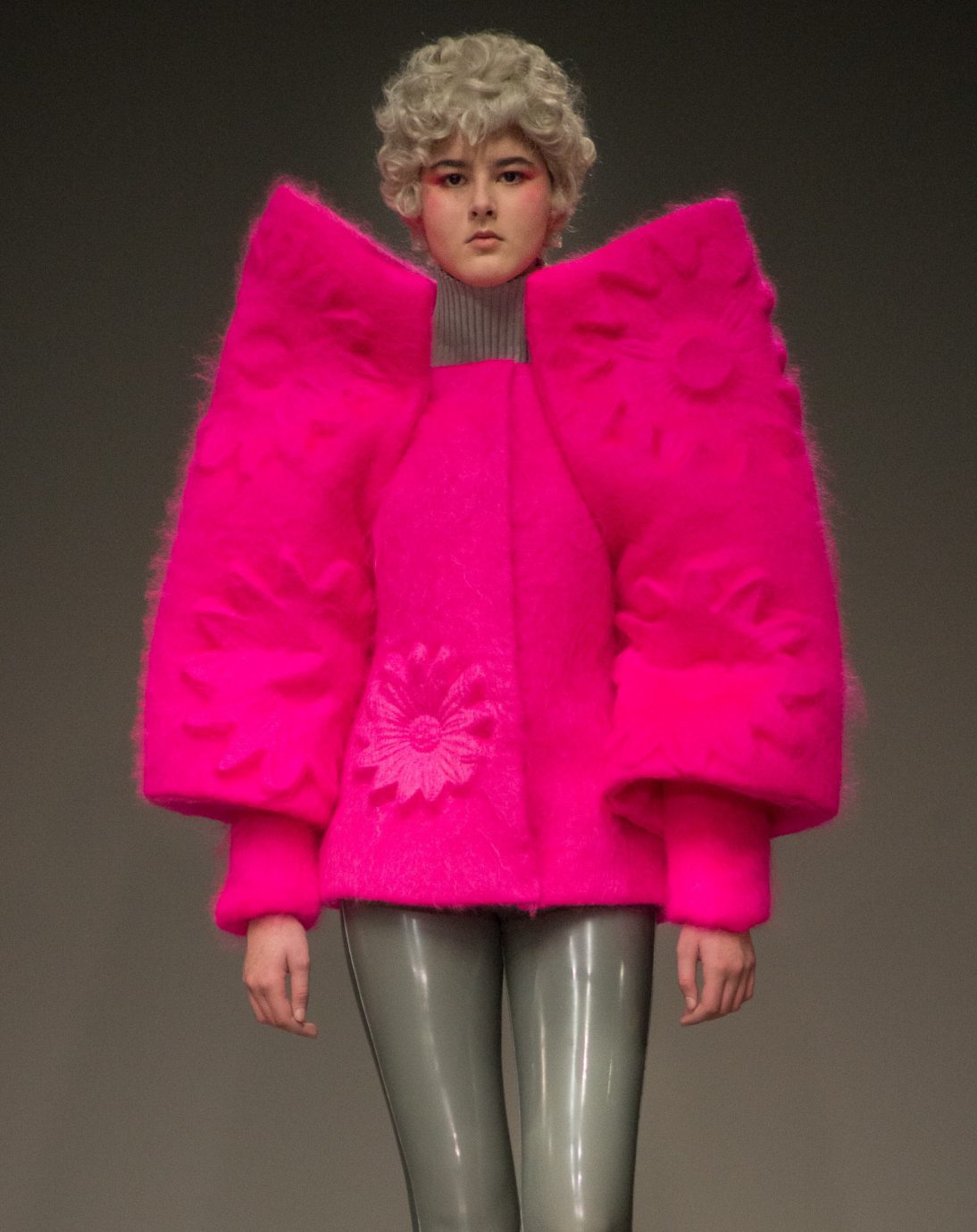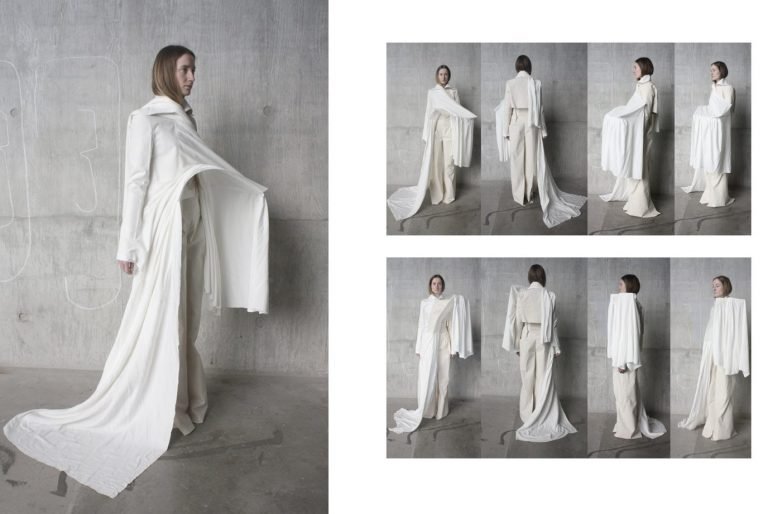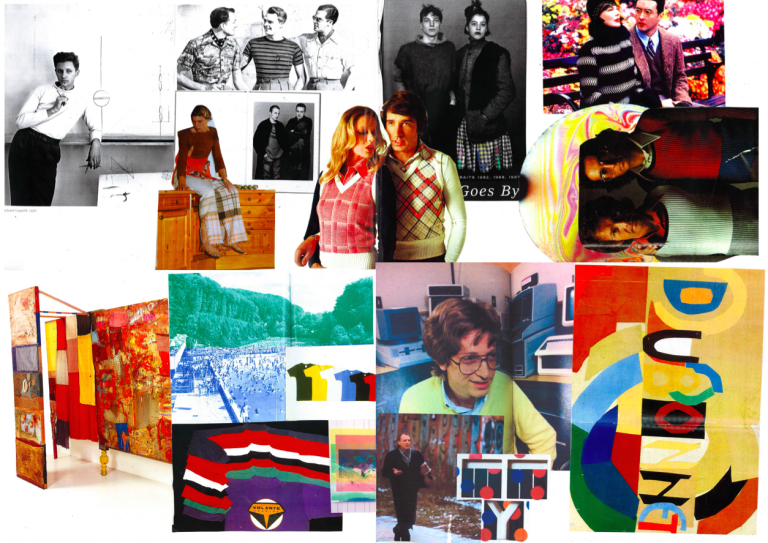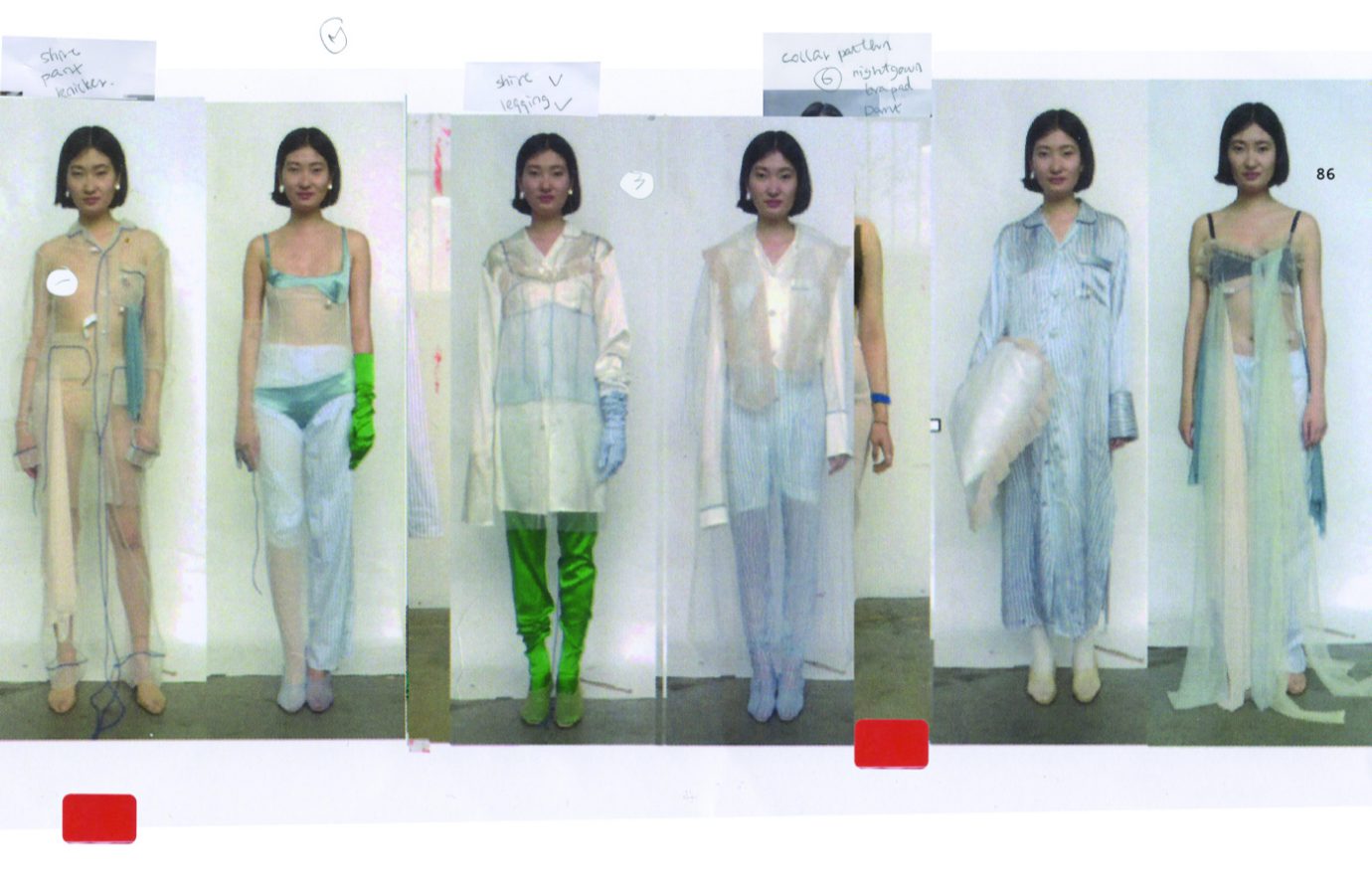How did your relationship with Daniel develop after his graduation?
I used to be the Fashion Knit Pathway Leader and Daniel was one of my students. I remember him from the very beginning. It was a very small pathway within the course, under 20 students, and we were in the old Charing Cross building by ourselves, on our own on the 6th floor. As a consequence, we were very close as a class, I got to know Daniel and his classmates very well. I’m a Northerner, not from the same place as Daniel, but we connected easily. On top of that, he really, really cared as a student. He was very hardworking.
Because it was the Knit Pathway, some students came onto the course with a real focus on textiles, but Daniel really cared about silhouette right from the beginning. He was an all-around fashion person. He was very interested in learning cutting and tailoring as well, interested in learning how to sculpt with the fabric he produced.
“You want students to look further, and help them find the best way of expressing what they want to say, regardless of what you think it should be.” – Sarah Gresty
Do you usually try to stay in touch with your ex-students?
There are times when students are all over the world, working with tight deadlines, so then you don’t really see or hear from them, but usually, they’ll reach a position where they are looking for interns and then I’ll receive the first email. Sometimes, I don’t see them for a year or two, but once you’re in the family, you’re always in the family. This might sound dramatic, but it’s true. Because you go through a lot together, don’t you?
At the open days, I always say to people that their peers will be just as important in their education as their tutors. You’ll be sitting next to someone from a Russian village who has learned a special embroidery technique from their grandmother, next is someone from Singapore, next to someone from Manchester,… and you’re all doing the same projects together, bringing your life experiences to the classroom. Your context and how you interpret the world are so interesting. That is why I feel so privileged as a tutor. I love one to one tutorials the best, where you sit talking to students and you find out so much. It’s an open dialogue and you can reflect together. It’s fascinating. I’m so nosey, so that’s what I really like. Encouraging the students to respond to their own ideas and teach them how to develop them.
“All the students are trying to say something. It’s never just making clothes for the sake of making clothes.” – Sarah Gresty
What do you mean by that?
When you have a class of twenty-something students, I can assure you that each brief will lead to twenty-something different outcomes. Based on how they interpreted the brief, you have to switch your head. You can’t tell them what you think you would do, but you need to enable them to see beyond what their first interpretation was. Maybe you’ve seen some films or an exhibition that might push them in a different direction. You want them to look further, and help them find the best way of expressing what they want to say, regardless of what you think it should be. Then I find myself googling things they say to me, and next time you see them you’ll have even more to say to them. It’s a two-way street.
Then, there is a lot of fragility within the student body, so you need to be able to identify the tipping point of every student because every student wants to feel challenged, they want to feel fulfilled. But some students haven’t got the mental capacity. You need to recognize the point where the student can take themselves and then say, “what you’ve done here is perfect, so we’re going to stop here and work on something else.” Because all the students are trying to say something. It’s never just making clothes for the sake of making clothes. Even when Daniel was a student it was already like that. You learn a craft, tell a story and say something through that.
But do you think the psychological element of tutoring has become more important recently?
Definitely. At the beginning of the academic year, we were in lockdown, we were teaching students who were stuck in their country. You can’t just leave them floundering. The whole point of enrolling in the course is that you learn but you also have to enjoy it. You need to be in an environment where you can thrive. You don’t want to traumatise people or leave them damaged.
I know when I speak to my contemporaries… I did see a lot of people leave college who did not enjoy it. We now know how short life is and how fragile it is. Surely, every decision we make should be enriching. It should be a challenge, but it should also be a bridge to understanding.
Indeed. I think the students feel the same way. Reading their interviews, I notice personal happiness seemed much more a priority than in the years before.
They prioritise community. This was the point of the show, it was really about community. We’re here together. It was a very intimate moment. I think everyone could empathise with what the students went through. Their ambitions were to come to CSM and they had many ideas of where that might take them. To then arrive and have the final year in complete isolation…
“Over the years, I have seen multiple students reach crisis points.” – Sarah Gresty
You mention that you and Daniel shared a cultural affinity, being both Northerners. With art schools being so incredibly international, how do you deal with those cultural differences?
Of course, some students come from other countries and they might be brought up not to question what a tutor says, so some students need to be encouraged to be brave and be confident to present and question the teacher.
Over the past few months, I have trained to become a mental health first aider. That has been very interesting. Because over the years, I have seen multiple students reach crisis points. I have tried to enroll many times before, but because I could study from home I could finally do it. That has been so interesting, it helped me understand how to be with students that might be more fragile than others. The course taught me to recognise warning signs.
Sadly there have been some horrendous tragedies within different creative universities. It shouldn’t happen. It’s very difficult for staff who haven’t been trained to deal with that to help their students. Obviously, there are very good counselors, but unless the student comes forward, it’s difficult to offer help.
This is an extreme amount of pressure for a tutor.
Absolutely, it is. There have been really frightening situations. Ultimately, we want the students to be challenged so they’ll feel fulfilled and can become creatives, but there is a very fine line between someone who has been challenged in a good way, or being pushed beyond their limit. Every student has a different position where that fine line is. Students feel a lot of pressure to work ridiculous hours, to go without sleep. It’s important to think in a healthier way.
The social circumstances have changed as well. The quality of life just isn’t the same for this generation. That is a lot to compensate for as an individual tutor.
There is a financial strain, all the time. Lots of students have to work a lot, alongside their course. It’s very difficult.
How early on do you recognize a student’s creative skills and talents?
This is the fifth year I have been course leader. I can definitely see how they have developed since their first year. Basically, your taste and aesthetic develops, but you’re still drawn to similar ideas, and I find that very interesting. I love taking pictures and then comparing their first-year work to their final project.
“As long as you have that desire, even if your creativity is dormant, we can help you find it. It’s all about desire.” – Sarah Gresty
Can students still surprise you in their development?
Very much! Even at an interview stage. I’ve been in interviews where the work has moved me so much and I’ll be convinced this is who everyone will be talking about, but then it falls flat, and other students who haven’t really recognized their personal identity yet, they might suddenly flourish. They are very young when they apply after all. Sometimes it does surprise me very much. That’s what makes it interesting.
To what extent can creativity be taught?
I think you need to be in an environment where you can thrive. If someone is in a stifling environment, their creativity can be flattened so much that it becomes very difficult to ever come back out again. I also think you need to have a real desire. As long as you have that desire, even if your creativity is dormant, we can help you find it. It’s all about desire.
And how do you spot that desire? Do you see it in conversation, or in the work they present?
Obviously, the foundation is fantastic, but the students all do the same projects, so you need to learn to spot something that enables them to show their individuality. At the application stage, there will always be a detail that draws your attention. It can be a single drawing, it might even be a reference of an obscure dancer, something you’ve never heard of.
I had a fantastic student a few years ago, Kawanishe, who graduated in 2011. He was from a very rural place in Japan, and he was incredibly informed about British culture. He told me he spent all his time in the countryside, researching on his computer all the time. I was very impressed by that.
In this example, isn’t there the risk that you’re judging foreign students by a Euro-centric standard?
We’re not judging his knowledge of our culture, we’re judging how he uses it to reflect on his own story and context. This particular student, for example, can reflect on something that happened a hundred years before he lived, in Paris, and his response to that, from his context, is very interesting. He can form his own identity and what he wants to say to people through his research on a Parisian artist. That is what is so fascinating.
So it’s about re-interpretation?
It’s about him being able to reflect on a Parisian artist from the context of his life experience. What we help the students do is, with rigour, look further into the research, develop their ideas. You and I, we’re both living in 2021, but your interpretation of what is going on will be entirely different from mine. Neither of ours is better than the other.
“As a tutor, you can’t have an ego.” – Sarah Gresty
You mentioned the importance of a nourishing environment. How much influence do you have on that as a tutor, especially during lockdown?
Obviously, the main thing about CSM is the student classes, being among your peers. What we did quite early on was organising different online clubs, such as film and yoga, for example. It wasn’t easy with the various timelines. I would have to get up very early for China, then stay up late for America. It did get really difficult, but connecting with the students was very important.
If there was a student who would usually be very meticulous about their looks, their hair, and make-up, and as weeks went by they stopped doing that, I would worry if they were okay and make sure they had friends they could talk to.
What are the most important qualities of a tutor that are often forgotten?
You can’t have an ego. The truth is that you can’t help but be more in tune with certain students. For whatever reason, you like their work more, but obviously, you can’t show that. You need to treat everyone equally. It is actually very difficult. I have a lot of requests from ex-students who want to tutor. People don’t realise how difficult it is, even if you have a lot of experience. You listen to everything the student says. At the end of the day, you are absolutely drained, both emotionally and intellectually. When the student is particularly fragile, you want to encourage them. You just want to help them get back to the position where they want to be investigative again about their own work.
Generally, the students are quite motivated. But you always need to remember everyone has their personal lives that might be affecting their work. You might find out that they are about to become homeless, and they can’t come to college.
What makes a good student?
A good student works hard. Questions you. And at some point in the course, they start to recognize their own aesthetic. Also, a good student is very nice and caring towards others.
It’s interesting, you’ve mentioned twice now that you want to be questioned by your students.
It’s very important. When they join in the first year, and someone comes to the first tutorial with their work, you’re trying to steer your student away from something that might already be done. But the student has all the right to say, no, this is what I’m doing, as long as they can reason it.
Then when do you fail a student?
A student would only fail if they haven’t done the work. I can’t think of a student that failed because their work wasn’t strong enough ‒ because we’ve been tutoring them after all. The process is the most important thing. It’s about what you learn on the way, not the end result. In the first year now, you just pass or fail, there’s no more grading. It’s probably much more healthy, it’s more about the feedback. You always get told something that you did really well and something you can improve on.
“The course enables you to reflect on what is going on through your personal identity, because you’re learning to construct around the body. Whatever is going on in the world, you can position it around that identity. You can use your skills in many ways.” – Sarah Gresty
Our industry is changing incredibly fast, there appears to be less hope. Do you notice the ambitions of your students have changed?
I have noticed that in a graduating year, increasingly more students will go into different creative fields. That is why I love the course, it teaches students to think beyond their garments. The boundaries have become so blurred. The students definitely have hope, they just aren’t describing themselves as designers anymore, they’re activists, writers, theatre designers. It’s such a wide arena now.
The course enables you to reflect on what is going on through your personal identity because you’re learning to construct around the body. Whatever is going on in the world, you can position it around that identity. You can use your skills in many ways.
Talking about boundaries, I noticed a lot of students who designed menswear within the womenswear pathway, and vice versa. Do you believe these divisions will continue to blur in the future?
Definitely. The pathways teach you a specialty. In menswear, you’ll learn tailoring, but those skills can be applied for any garment or any gender. Increasingly, more and more students are using what they learn to develop their work. This year, the students modeled themselves, so this pushed those categories even more.
Do you think the fact that the students worked on their own bodies might also change some norms around the body types used in fashion design and imagery?
I hope so! We’ve been trying to cast more diverse for a while now. The designers were very nervous to model, but it just looked much more human. It’s great that they were forced to wear their designs because then you become more aware of what it feels like to wear these clothes.
Why do you think these beauty standards remain so persistent?
We have had the mannequins we work within college for a long time. They are very expensive, so the larger sizes are only coming in slowly. Still, a lot of students prefer to work on the smaller ones. We say to them, “how many people do you actually know with that body shape?” I don’t know why students are so stuck on using the tiny mannequins.
On 1 Granary, we’ll regularly interview design students who are exploring body diversity through their work, but then you scroll through our Instagram, the work in process, and it’s almost exclusively white, thin, young models that are used for fitting. We select those images because we like the design, so we don’t notice it, but when you see them all together, it’s very clear that we’re further away from accepting a variety of bodies than we think.
I notice that too. You’ll find that when our website opens next week, you’ll see less of that this year, but I know what you mean, it surprises me too.
What do you hope your students learn in the four years with you?
I hope they… this sounds very corny, but I love to see students arrive on the course and slowly open up, coming into the environment ‒ they start to feel braver and more confident. They start to become the people they want to be. Lots of them might choose not to go into fashion, but that’s fine because they’ve learned to discipline their creativity. They pushed themselves, they challenged themselves. They have made lifelong friends.
When students leave I always encourage them to email me. I’m very interested to see what they’re all doing, in the coming years.
Read about this year’s CSM BA Fashion show here









